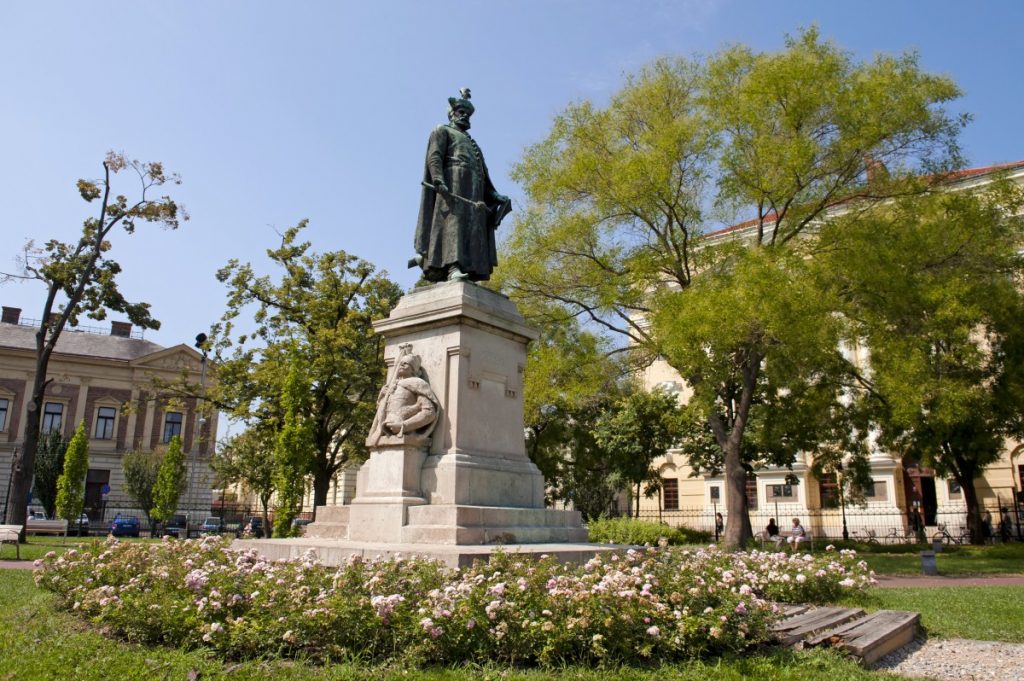Herb Garden (Füvészkert)
Debrecen has a tradition of science education and botany. The legacy of botany began with the work of Sámuel Diószegi and Mihály Fazekas, the co-authors of the famous ”Hungarian Herb Book” (1807), and the work carried out in the first Herb Garden (Füvészkert).
The garden was completed in 1840 on the site of today’s Déri Museum and was under the supervision of the Reformed College and served for the purpose of science education. In the meantime, the university was established in the College and then its location moved to Great Forest when its impressive building was completed. With this move, the herb garden of the College lost its purpose and the site was repurposed when the Déri Museum was built.
Memorial Garden
The driving force behind the establishment of the Memorial Garden (Emlékkert) was the transformation of the area behind the Great Church, which was abandoned after the fire of 1802. It was transformed into the cultural, literary, and historical space that it remains today. Members of the Memorial Garden Society, founded in 1861, suggested creating a statue park in the sheer square in front of the Reformed College, a concept that was later implemented.
The first statue of the fenced-in sculpture park was the Csokonai statue created by Miklós Izsó. It signaled the Debrecen people’s commitment to the Csokonai cult.
You can also see here the Bocskai statue which is the work of the sculptor Barnabás Holló. It was erected by the city of Debrecen in 1906, on the occasion of the 300th anniversary of the Vienna Peace Treaty. The Transylvanian prince István Bocskai was a staunch defender of religious freedom and a patron of the local Reformed College. It was he who convinced the “hajdúk” (Hungarian ethnic group) people who had converted to Calvinism, to settle around Debrecen.

As a result of the War of Independence against Habsburg, led by Bocskai, the Peace treaty of Vienna concluded in 1606, and granted public recognition to the Lutherans and the Reformed movement in the Kingdom of Hungary.
The “Gályarabok” (Galley prisoners statue) memorial statue was erected in 1895 with the support of a gracious widow from Debrecen, Mihály Hegyi. It commemorates the names of 41 Protestant pastors who were summoned to the Bratislava court in 1673, convicted on fabricated charges, and then sold in 1675 as galley prisoners. Finally, the Dutch Admiral Michiel de Ruyter was commissioned to evacuate them. On February 11, 1676, he was able to take twenty-six of them to his ship. The memorial site has received a special role in the process of Protestant-Roman Catholic historical reconciliation two decades ago when Pope John Paul II laid a wreath on it on 18th August 1991. This event is commemorated on the monument today by a separate bronze wreath.
Cemetery Garden
Last but not least, the former “cemetery garden” on Hatvan street is turned to a historical memorial park of Debrecen, where you can find here the tomb of Mihály Csokonai Vitéz, poet, a former student of the Debrecen Reformed College and a famous native of Debrecen. His tomb was erected in 1836 in the former Hatvan Street Cemetery. In 1929, when the cemetery was liquidated, city leaders wanted to move it but the citizens were against it. In the end, the tomb was no longer disturbed, in fact, the tomb was repainted and landscaped in 1938.
The literary hall of the Déri Museum presents the change of the city through the cult of the symbolic figures of the city, Mihály Csokonai Vitéz. The exhibition space, connected by three spaces – the Herbal Garden, the Memorial Garden, and the Cemetery Garden – in the memory of Csokonai, represents an imaginary garden that serves as a place to sit and contemplate. However, if you have the time, all those places are worth a visit.